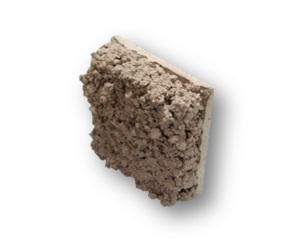This website uses cookies so that we can provide you with the best user experience possible. Cookie information is stored in your browser and performs functions such as recognising you when you return to our website and helping our team to understand which sections of the website you find most interesting and useful. More information in our Privacy Policy
Geopolymers from recycling materials
Valorization of industrial waste and industrial by-products
Principal investigators: Valentina Medri, Elena Landi, Annalisa Natali Murri
Involved personnel: Elettra Papa, Francesco Miccio, Cesare Melandri
Geopolymers are eco-sustainable materials because in addition to the low consolidation temperature, secondary raw materials can be used for their production. Depending on the final application of the product, ISSMC recycles as raw materials, inert or partially inert fillers, waste and industrial by-products of various kinds, some of which are examples.
- Powders and granules:
– Ashes from waste-to-energy processes (fly ash, bottom ash, biomass ash) are used as alkali-silicate raw material. Mixed biomass ashes (vegetal-animal) also contain hydroxyapatite (calcium phosphate) are partially reactive. Biomass ashes have been used to produce porous insulators such as sandwich panel cores with skins of fibrous reinforced basalt fiber in the POR-FESR EEE-CFCC project and they are studied in the PNRR ECOSISTER (SPOKE 5) project.
– Silica fume is a by-product of the industrial production of electric silicon metal and ferro-silicon alloys. The metal silicon present as impurity can be used as a blowing agent to produce foams by direct foaming.
– Waste from construction and demolition operations (CDW) (POR FESR REWINDS project), as well as porcelain stoneware waste that comes from cutting and production scrap, can be used in the form of grit and sand as raw material, since partially reactive in alkaline solution thanks to their glassy phase.
– Industrial sediments (sludge, excavation residues, etc.), the subject of the PRIN SEEDS project, currently classified and treated as waste, can also be used as raw materials or partially reactive fillers.
- Fibers:
– Sheep wool from industrial waste is used in staple and felt to produce thermo-structural and insulating composites. Of particular interest are the properties of keratin for the release of nutrients in the soil and for the maintenance of moisture: containers for the early germination and soil improvers in the granules for horticulture have been made.
– Basalt fibers and carbon fibers from fabric processing or exhausted tires are used as a secondary reinforcement phase for thermostructural materials resistant to thermal shock such as felts and short-fibre fiber-reinforced panels (EIT Raw Materials FENICE project) and refractory molds for casting of complex shapes (POR FESR FIREMAT project).
Tools and Processes
The geopolymerization process is a reaction between an aluminosilicatic powder and an aqueous solution of hydroxides or alkaline silicates which, based on cations (commonly Na+, K+, but also Li+, Cs+), affects the final mechanical and thermal properties. Phosphate based geopolymer materials are the acid-base products of bi- and tri-valent metal oxides with aqueous phosphates in aqueous solution. Synthesis temperatures are lower than 100 ° C for “alkaline” and less than 300 ° C for phosphates. Mechanical mixing is required to complete the reaction. ISSMC is equipped with shear mixer (Planetary Centrifugal Mixer “THINKY MIXER” ARE-500). Hand layup and vacuum bagging or vacuum infiltration processes are used for fiber-reinforced composites.
Main Collaborations
- Tecnologie dei Materiali Faenza (ENEA-TEMAF)
- Centro Interdipartimentale per la Ricerca Industriale di Meccanica Avanzata e Materiali (CIRI-MAM)
- CertiMaC Soc. Cons. a Resp. Limitata (CERTIMAC)
- Tampieri Energie srl
Projects
Publications and patents
- Natali Murri A., Medri V., Papa E., Laghi L., Mingazzini C., Landi E Porous geopolymer insulating core from a metakaolin/biomass ash composite Environments 2017, 4(4), 86
- Natali Murri A, Medri V, Landi E, Production and thermo-mechanical characterization of wool-geopolymer composites, Journal of the American Ceramic Society (2017), 100 (2017) 2822–2831
- Papa E, Medri V, Kpogbemabou D, Morinière V, Laumonier J, Vaccari A, Rossignol S, Porosity and insulating properties of silica-fume based foams, Energy and Buildings 131 (2016) 223–232.
- Natali Murri, E. Papa, V. Medri, E. Landi, Design of wool-geopolymer pots, Ceramic Engineering and Science Proceedings 35[8] (2014) 79-86.

